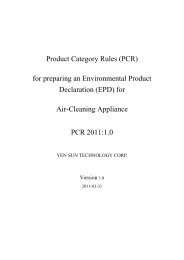Product Category Rules (PCR) - PCR Library
Product Category Rules (PCR) - PCR Library
Product Category Rules (PCR) - PCR Library
You also want an ePaper? Increase the reach of your titles
YUMPU automatically turns print PDFs into web optimized ePapers that Google loves.
(8) Giveaways<br />
Articles which are attached to the goods for sales promotional purposes when<br />
they are sold, and do not constitute any part of such goods or the containers or<br />
packaging thereof, such as a small toy enclosed in a box of candy.<br />
(9) Intermediate processed goods<br />
Base materials and components used to manufacture plastic containers and<br />
packaging, such as rolls of raw materials for plastic films and sheets, and<br />
preforms for plastic bottles.<br />
(10) Plastic films (refer to JIS Z 8123: 1995 and JIS Z 0108: 2005)<br />
Thin and flat products whose thickness is extremely thin relative to their length<br />
and width with its maximum thickness being limited to a specified value, and<br />
which are usually supplied in roll form. They shall be made of plastics and in<br />
film form with a thickness of less than 0.25 mm.<br />
(11) Plastic sheets (refer to JIS Z 8123: 1995 and JIS Z 0108: 2005)<br />
Thin and flat products whose thickness is extremely thin relative to their length<br />
and width with its maximum thickness being limited to a specified value, and<br />
which are usually supplied in roll form. They shall be made of plastics and in<br />
sheet form with a thickness of 0.25 mm or more.<br />
(12) Bottles (refer to JIS Z 0108: 2005)<br />
Rigid or semi-rigid containers composed of body, bottom and mouth portions.<br />
Generally, the body portion is narrowed below the mouth to form shoulder and<br />
neck portions. The mouth shall be sealed with a closure such as stopper made<br />
of body material, cork stopper, crown cap or screw cap. Bottles made of PET<br />
and plastics are usually called “PET bottles” and “plastic bottles,” respectively,<br />
to distinguish between them.<br />
(13) Designated PET bottles<br />
PET bottles required to be attached with an identification mark in accordance<br />
with the “Law for the Promotion of Effective Utilization of Resources:<br />
Designated Labeled <strong>Product</strong>s”. The contents of such bottles include refreshing<br />
drink, soy sauce, alcoholic beverages, mirin seasoning, milk and dairy products,<br />
and seasonings specified by the Law above.<br />
(14) Trays (refer to JIS Z 0108: 2005)<br />
Shallow containers made of relatively rigid materials.<br />
(15) Foamed polystyrene containers (refer to JIS Z 0108: 2005)<br />
Cushioning packaging materials molded by heating and foaming polystyrene<br />
beads containing liquefied gas or chemical foaming agents in the mold. They<br />
are also called “EPS containers”.<br />
(16) Roll products (refer to JIS P 0001: 2008)<br />
Thin and flat products in sheet or film form which are wound into roll form so<br />
that they can be transported easily and safely.<br />
(17) Sealing (refer to JIS Z 0108: 2005)<br />
- A technique to put the goods or packaged goods into containers or packaging,<br />
and close the openings to protect the goods inside.<br />
- Sealing methods include mechanical sealing or bundling, sealing with tapes,<br />
sealing with adhesives, sealing with stamps, and heat-sealing.<br />
(18) Open recycling (refer to “EcoLeaf Method of Calculating <strong>Product</strong><br />
Environmental Load during Recycling/Reuse”; Japan Environmental<br />
Management Association for Industry: 2004)<br />
- Recycling of waste products as materials or raw materials for products of<br />
different types from the original ones. It is also called “cascading” or<br />
-4-















